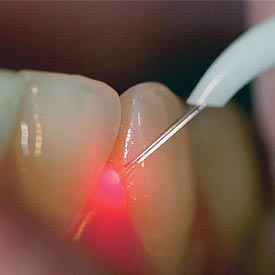laser dentistry cost,pros, and cons of laser dentistry, laser dentistry courses, laser dentistry pediatric, does laser dentistry hurt, laser dentistry root canal, laser in dentistry slideshare
Lasers have been used in dentistry since 1994 to treat a number of dental problems. Yet, despite FDA approval, no laser system has received the American Dental Association’s (ADA) Seal of Acceptance as an alternative to more traditional treatment. That seal assures dentists that the product or device meets ADA standards of safety and efficacy, among other things. The ADA, however, states that it is cautiously optimistic about the role of laser technology in the field of dentistry. These lasers are different from the cold lasers used in photo therapy for the relief of headaches, pain, and inflammation.

Still, some dentists are using lasers to treat:
- Tooth decay. Lasers are used to remove decay within a tooth and prepare the surrounding enamel for receipt of the filling.
- Gum disease. Lasers are used to reshape gums and remove bacteria during root canal procedures.
- Biopsy or lesion removal. Lasers can be used to remove a small piece of tissue (called a biopsy) so that it can be examined for cancer. Lasers are also used to remove lesions in the mouth and relieve the pain of canker sores.
- Teeth whitening. Lasers are used to speed up in-office teeth whitening process. A peroxide bleaching solution, applied to the tooth surface, is ”activated” by laser energy, which speeds up the whitening process.
How Do Lasers Work in Dentistry?
All lasers work by delivering energy in the form of light. When used for surgical and dental procedures, the laser acts as a cutting instrument or a vaporizer of tissue that it comes in contact with. When used in teeth-whitening procedures, the laser acts as a heat source and enhances the effect of tooth-bleaching agents.
